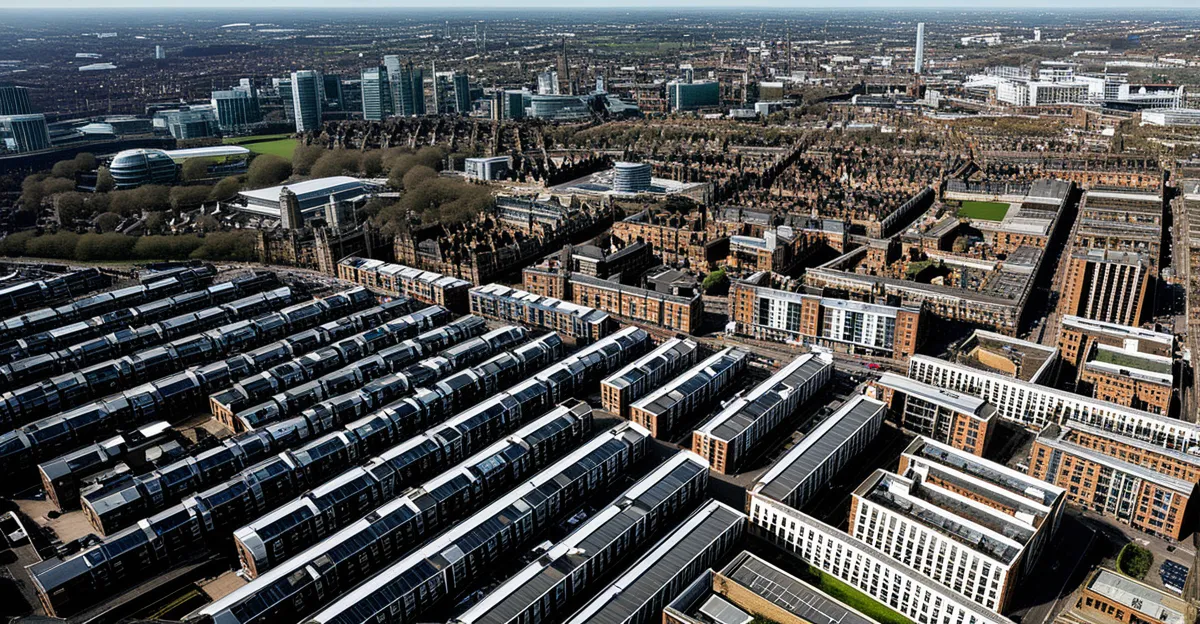The Relationship Between Urban Development and Real Estate Values in the UK
Urban development in the UK involves the planned expansion and revitalisation of cities, encompassing residential, commercial, and recreational spaces. This transformation significantly influences property values UK, as new amenities, improved infrastructure, and enhanced cityscapes attract buyers and investors.
The real estate market analysis consistently demonstrates that areas undergoing urban development typically experience higher property demand, pushing values upwards. This is largely due to improved living conditions, job creation, and better services resulting from thoughtful city planning effects. Urban growth fosters connectivity and accessibility, elements crucial for rising local property prices.
Topic to read : How Can Economic Trends Impact Property Investments in the UK?
Key drivers linking urban development and property price trends include infrastructure improvements, regeneration projects, employment opportunities, and enhanced public spaces. For instance, the introduction of new transportation links or green spaces often corresponds with increased real estate demand. However, the effects vary by location and the scale of development, making detailed market studies essential for accurate predictions in the evolving UK property landscape.
The Relationship Between Urban Development and Real Estate Values in the UK
Urban development in the UK refers to planned changes in city landscapes, infrastructure, and housing aimed at accommodating population growth and economic shifts. This process often involves construction, regeneration, and improvements to transport and public amenities. Its influence on property values UK is significant, as urban growth tends to increase demand for real estate.
In the same genre : How can one effectively evaluate the impact of economic policies on UK real estate investments?
The overall impact of urban development is generally positive on property prices. As cities expand and regenerate, areas become more attractive for residents and businesses alike, pushing up property values UK. Key drivers include improved connectivity, enhanced amenities, and proximity to employment hubs. For example, urban renewal often brings new shopping centres, parks, or cultural venues, raising desirability.
City planning effects also play a crucial role. Zoning decisions and infrastructure investments can create supply constraints or stimulate growth, directly affecting market dynamics. Understanding these factors is vital in real estate market analysis to predict future value trends and identify promising investment locations. The interplay between urban development and real estate is complex but clearly tied to rising property values in the UK, reflecting both economic vitality and strategic planning outcomes.
Regeneration Projects and Their Influence on Property Prices
Regeneration UK schemes, such as London Docklands and Manchester’s city centre rebuilds, demonstrate how focused investment can drive significant property price increase locally. These projects typically revitalise derelict or underused areas, introducing mixed-use developments that boost both residential and commercial demand.
In the short term, regeneration projects often spark heightened interest, leading to a swift rise in property values due to improved amenities and infrastructure. However, sustained growth depends on continued investment and successful integration into the wider urban fabric—long-term appreciation may vary based on economic conditions and policy support.
Case studies reveal that areas once unattractive to buyers transform into thriving hubs. London Docklands, for example, saw property values multiply as new offices, housing, and transport connections emerged. Manchester’s regeneration similarly boosted market confidence, attracting investors and residents alike.
Such projects also highlight potential challenges, including gentrification and displacement, though their positive impact on property values UK remains evident. Detailed real estate market analysis underscores regeneration’s role as a crucial driver of urban economic renewal and changing property price trends.
Regeneration Projects and Their Influence on Property Prices
Urban regeneration projects in the UK, such as London Docklands and Manchester’s Salford Quays, have had profound effects on property price increases and local market dynamics. These schemes often transform neglected or underused areas into vibrant mixed-use communities with improved infrastructure and amenities, attracting residents and investors alike.
In the short term, regeneration projects can cause rapid spikes in property values due to heightened demand and speculative interest. However, long-term value appreciation depends on sustained economic growth and continued investment in the area. For example, London Docklands experienced significant property value growth over decades, driven by commercial and residential development alongside transport improvements.
Case studies consistently illustrate that effective regeneration strategies combine infrastructure upgrades, enhanced public spaces, and job creation, fostering a positive cycle that supports rising property price increases. Yet, it is critical to assess each project individually, as variations in scale, planning, and economic context influence outcomes across the UK.
Understanding these nuances enhances real estate market analysis and guides stakeholders in leveraging regeneration’s full potential in boosting property values UK.
Infrastructure Upgrades and Market Demand
Urban growth in the UK is closely tied to transport infrastructure UK developments, which significantly affect connectivity property values. Major projects like Crossrail and HS2 highlight how enhanced transport networks stimulate real estate market analysis trends by making areas more accessible and attractive. These improvements often lead to noticeable increases in property demand, especially in residential markets located near new or upgraded stations.
The impact on property values UK varies by sector. Residential properties typically see value growth due to commuter convenience, while commercial properties benefit from improved logistics and business accessibility. However, regional differences exist; London’s market reacts differently to infrastructure investment compared to northern cities, where demand shifts depend on local economic conditions and project scale.
Infrastructure investment effects extend beyond immediate price hikes. Enhanced connectivity can spur long-term urban regeneration, attracting further development and investments. Therefore, understanding the relationship between transport upgrades and market demand is critical in evaluating future property values UK trends and identifying emerging opportunities in both housing and commercial real estate sectors.
Infrastructure Upgrades and Market Demand
Enhancements to transport infrastructure UK play a pivotal role in shaping real estate demand and connectivity property values. Projects such as Crossrail and HS2 notably increase accessibility, making previously peripheral locations more attractive to buyers and investors. This accessibility improvement typically leads to noticeable uplift in property values UK near new or upgraded transport links.
The effect differs between residential and commercial sectors. Residential properties often see immediate value appreciation due to easier commutes and increased desirability. Commercial properties benefit from improved business accessibility and logistics, bolstering local economic activity. However, the magnitude of change is region-dependent, with metropolitan areas experiencing more pronounced benefits compared to rural locales.
Infrastructure investment effects extend beyond mere transport. Upgraded public transit, road improvements, and enhanced cycling routes collectively enhance urban mobility, contributing to sustained demand growth. Real estate market analysis frequently highlights these investments as essential drivers underpinning rising property values UK. Consequently, strategic infrastructure development emerges as a cornerstone for urban growth, influencing both market dynamics and wider economic prospects.
The Relationship Between Urban Development and Real Estate Values in the UK
Urban development in the UK encompasses the deliberate planning and enhancement of city landscapes, infrastructure, and housing to manage population growth and economic changes. Typically, this development involves new construction, transportation upgrades, and improved public amenities. These efforts collectively influence property values UK by increasing demand within reshaped urban areas.
The overall impact of urban growth on real estate values is positive. Areas benefiting from well-executed urban development generally experience rising property prices due to enhanced living conditions and better services. Key drivers linking urban change and property price trends include improved transport connectivity, introduction of green spaces, and proximity to employment centres. For example, efficient city planning effects such as zoning regulations and targeted infrastructure investment often create environments that attract both residents and investors.
Detailed real estate market analysis shows that urban development can create supply constraints or stimulate new construction, both affecting market dynamics. Thus, understanding the causes and results of urban development is critical for predicting future property value trends and making informed investment decisions.
The Relationship Between Urban Development and Real Estate Values in the UK
Urban development in the UK encompasses planned changes in infrastructure, housing, and public spaces aimed at supporting growing populations and evolving economies. This process significantly influences property values UK by increasing the attractiveness and functionality of urban areas. Key factors linking urban growth to rising property prices include improved transportation links, expanded amenities, and job creation, all underscored by strategic city planning effects.
Real estate market analysis frequently shows that well-executed urban development spurs demand across residential and commercial sectors. For example, enhanced connectivity reduces commute times, making locations more desirable, which directly elevates property values UK. Additionally, mixed-use developments create vibrant communities that attract investors and new residents alike.
The role of city planning effects is critical: zoning laws and infrastructure investments shape supply and demand by either constraining availability or enabling expansion. Understanding these dynamics provides a clear picture of how urban change drives property price trends. Thus, urban development acts as a fundamental catalyst shaping the UK’s real estate landscape.
The Relationship Between Urban Development and Real Estate Values in the UK
Urban development in the UK involves the deliberate transformation of city environments through new construction, infrastructure upgrades, and enhanced public amenities. This planned growth directly influences property values UK by creating areas that attract residents and investors, driven by improved living standards and economic opportunities.
The overall impact of urban growth on real estate is generally positive. Areas undergoing urban development typically see rising demand and price increases, a trend well supported by real estate market analysis. Key drivers include enhanced transport links, introduction of green spaces, and closer proximity to employment hubs. These factors work together to boost market confidence and property desirability.
City planning effects play a crucial role in directing growth, balancing supply and demand through zoning, infrastructure investment, and housing policies. Strategic planning can stimulate new developments or restrict supply, both affecting price trends. Recognizing the importance of urban development’s multifaceted impact helps investors and policymakers anticipate shifts in property values UK and make informed decisions based on evolving city dynamics.
The Relationship Between Urban Development and Real Estate Values in the UK
Urban development in the UK refers to deliberate, planned improvements encompassing infrastructure, housing, and public amenities designed to accommodate population growth and economic shifts. This multifaceted process includes new construction, regeneration, and transport upgrades, all of which influence property values UK by reshaping neighbourhood desirability and accessibility.
The overall impact of urban growth on the real estate market is positive. Well-executed urban development typically leads to increased demand, pushing property prices upward. Key drivers connecting urban change to property price trends include enhanced transport links, creation of green spaces, and proximity to employment centres. For example, strategic city planning effects such as zoning and targeted infrastructure investment can either constrain supply or enable expansion, thus directly impacting market dynamics.
According to comprehensive real estate market analysis, urban development fosters both short-term boosts and sustained value growth by making locations more attractive for residents and investors. Understanding these drivers and their interplay is essential for accurately predicting future property trends and making informed investment decisions within the evolving UK property landscape.
The Relationship Between Urban Development and Real Estate Values in the UK
Urban development in the UK is the strategic process of modifying city landscapes through new construction, infrastructure enhancements, and upgraded public amenities. This planned growth aims to address demographic changes and economic shifts while shaping urban functionality. The relationship between urban development and property values UK is notably strong, with growth usually translating into increased demand across residential and commercial sectors.
Key drivers connecting urban change to property price trends include improved transport links, expanded public spaces, and proximity to employment centres. These factors enhance desirability, stimulating buyers and investors alike. Additionally, city planning effects—such as zoning regulations and infrastructure investment—play a decisive role in moderating supply and demand dynamics. Efficient planning can either encourage new developments or impose constraints that push prices higher.
Real estate market analysis consistently highlights that areas undergoing coherent urban development experience rising property values UK, reflecting economic vitality and enhanced quality of life. Understanding this intricate balance helps stakeholders anticipate market shifts and supports informed investment strategies within the UK’s evolving urban environment.
The Relationship Between Urban Development and Real Estate Values in the UK
Urban development in the UK refers to the coordinated expansion and improvement of urban areas through construction, infrastructure, and public amenity enhancements. This planned growth aims to accommodate population increases and economic shifts while reshaping local environments. The overall impact of urban development on property values UK is predominantly positive, as improved amenities and connectivity boost demand.
Key drivers linking urban growth to property price trends include enhanced transport links, introduction of green spaces, and proximity to employment hubs. For instance, strategic city planning effects such as zoning and infrastructure investment directly influence supply and demand dynamics, either constraining or enabling new developments. These factors collectively increase desirability, driving price appreciation.
Detailed real estate market analysis supports this relationship, showing that well-executed urban development elevates both short-term interest and long-term value in affected areas. Such analysis considers the interplay of economic vitality, planning strategies, and demographic changes, providing clear evidence of urban development’s crucial role in shaping evolving UK property markets.
The Relationship Between Urban Development and Real Estate Values in the UK
Urban development in the UK involves strategic enhancements to infrastructure, housing, and public amenities to support population growth and economic progress. This comprehensive process reshapes urban landscapes, improving neighbourhood desirability and accessibility, which directly influences property values UK.
The overall impact of urban growth on real estate is predominantly positive. Areas experiencing well-planned development usually see increased demand, driving price appreciation. Key drivers linking these trends include improved transport connectivity, creation of green spaces, and proximity to employment centres. For instance, strategic city planning effects like zoning reforms and targeted infrastructure investment can either limit or enable new construction, significantly shaping supply and demand dynamics.
Comprehensive real estate market analysis reveals that these factors work together to generate both immediate boosts and sustained growth in property values. Understanding these elements equips investors and policymakers with the insight needed to anticipate market shifts. This interplay of urban development and market forces remains crucial in shaping future property values UK across diverse regions.
The Relationship Between Urban Development and Real Estate Values in the UK
Urban development in the UK encompasses carefully planned changes to infrastructure, housing, and public spaces designed to meet demographic and economic demands. This development, broadly defined, involves new construction, regeneration, and enhancements to transport and amenities. Its direct influence on property values UK is significant, often driving increased market demand and consequent price growth.
The overall impact of urban growth on real estate values is positive. Enhanced connectivity, improved public spaces, and proximity to employment hubs are key city planning effects that elevate desirability. For example, smart zoning policies and targeted infrastructure investments can either limit supply or stimulate development, shaping demand dynamics visibly.
According to detailed real estate market analysis, these urban changes typically result in both short-term price spikes and longer-term appreciation. The interplay of improved amenities, transport links, and strategic planning fosters environments that attract residents and investors alike. Understanding how these factors link together is essential for predicting trends in property values UK and developing effective investment strategies.





